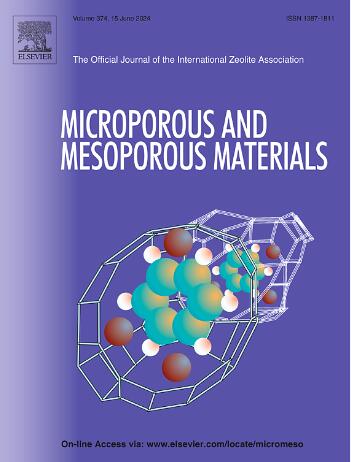Effective elimination of Congo red dye from tannery wastewater using Fe-pillared bentonite: Synthesis, adsorption isotherm, kinetics, and optimization via Box-Behnken design
IF 4.8
3区 材料科学
Q1 CHEMISTRY, APPLIED
引用次数: 0
Abstract
Untreated tannery wastewater with a high concentration of Congo Red (CR) dye can harm the ecosystem and public health. Therefore, Iron-pillared bentonite (Fe-PB) was synthesized and evaluated for its ability to remove CR dye from tannery wastewater. The effect of OH−/Fe3+ molar ratio within the range of 1.2–2.4 on the physico-chemical properties of Fe-PBs was examined. The solids obtained were characterized by XRF, XRD, BET, and SEM analyses, which confirmed that the pillaring process was successful. The adsorption process was optimized using response surface methodology combined with the Box-Behnken design (RSM-BBD). For both raw bentonite (RB) and Fe-PB2.0 clays, the optimized conditions were found at 0.03 g adsorbent mass, pH solution 2, 45 °C temperature, and 115 min contact time. The maximum adsorption capacity of CR reached 95.72 mg/g for RB and 175.75 mg/g for Fe-PB2.0, due to an increase in specific surface area, from 78 m2/g for RB to 190 m2/g for Fe-PB2.0. The pseudo-second-order kinetic and Freundlich models indicated a better fit with the adsorption data. Moreover, five adsorption-desorption cycles were used in regeneration studies, and the removal rate of Fe-PB2.0 varied from 98 to 86 %, indicating the material's great potential for reuse. Before and after the adsorption experiments, several physicochemical characteristics of the tannery wastewater were examined, including pH, conductivity, turbidity, BOD5, COD, and CR content. The study highlights the potential of the pillared bentonite clay as a cost-effective adsorbent for treating tannery wastewater and indicates the effectiveness of the RSM-BBD approach for modeling and optimization.

求助全文
约1分钟内获得全文
求助全文
来源期刊

Microporous and Mesoporous Materials
化学-材料科学:综合
CiteScore
10.70
自引率
5.80%
发文量
649
审稿时长
26 days
期刊介绍:
Microporous and Mesoporous Materials covers novel and significant aspects of porous solids classified as either microporous (pore size up to 2 nm) or mesoporous (pore size 2 to 50 nm). The porosity should have a specific impact on the material properties or application. Typical examples are zeolites and zeolite-like materials, pillared materials, clathrasils and clathrates, carbon molecular sieves, ordered mesoporous materials, organic/inorganic porous hybrid materials, or porous metal oxides. Both natural and synthetic porous materials are within the scope of the journal.
Topics which are particularly of interest include:
All aspects of natural microporous and mesoporous solids
The synthesis of crystalline or amorphous porous materials
The physico-chemical characterization of microporous and mesoporous solids, especially spectroscopic and microscopic
The modification of microporous and mesoporous solids, for example by ion exchange or solid-state reactions
All topics related to diffusion of mobile species in the pores of microporous and mesoporous materials
Adsorption (and other separation techniques) using microporous or mesoporous adsorbents
Catalysis by microporous and mesoporous materials
Host/guest interactions
Theoretical chemistry and modelling of host/guest interactions
All topics related to the application of microporous and mesoporous materials in industrial catalysis, separation technology, environmental protection, electrochemistry, membranes, sensors, optical devices, etc.
 求助内容:
求助内容: 应助结果提醒方式:
应助结果提醒方式:


